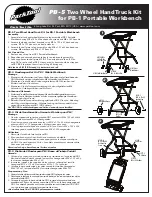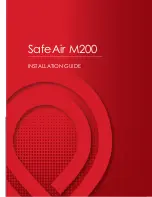
36
INSTALLATION OF CAR'S UPPER ANCHOR FITTING
INSTALLATION OF CAR'S UPPER ANCHOR FITTING
37
IF THE CAR IS FITTED WITH CHILD
RESTRAINT UPPER ANCHORAGE POINT
Locate the anchorage point behind the rear seating position.
(consult the car owners handbook for the location of the
upper anchorage point). The anchorage point should be
directly behind and central to the restraint. Remove thread
plug from the parcel shelf/floor/roof, etc. and install anchor
bolt and fitting as shown in Fig.1.
CAUTION: DO NOT OVERTIGHTEN ANCHOR BOLT.
OVERTIGHTENING MAY FRACTURE OR BREAK BOLT.
MAXIMUM TORQUE IS 20 Nm.
(14.75 ft.lb.)
Note: Minimum of five full turns of anchor bolt is required
before tightening force is applied.
IF THE CAR IS NOT FITTED WITH CHILD
RESTRAINT ANCHORAGE POINTS
For Sedans only
- Drill 9mm diameter hole in the parcel
shelf on the centre line of the seating position as shown
in Fig.3. Before drilling the hole, check the underside for
accessibility. Install the anchor bolt as shown in Fig.2.
It is recommended that this installation be carried out by a
child restraint fitting station or licenced motor mechanic.
For vehicles other than Sedans
- In Australia, consult your
nearest child restraint fitting station or traffic authority for
vehicle inspection to find the best, correct position for the
placement of the upper anchorage point, and for the correct
attachment bolt length and use of spacers. In New Zealand,
consult the agent for the vehicle.
Note to Queensland purchasers: The installation of
anchorage points must be approved by authorised officers
appointed by Queensland Transport. Authorised officers can
be sourced from all Queensland Transport Customer Service
and Queensland Ambulance Service Centres.
Front of Vehicle
Attachment Bolt
Anchor fitting
Spacer(s) if
required
Vehicle metal
structure
Reinforcing
washer (cone
downwards)
Lock washer
Secure nut
UPPER ANCHORAGE
FITTINGS FOR SEDANS ONLY
Vehicle trim
Fig.2.
UPPER ANCHORAGE FITTING
Attachment Bolt
Lock washer
Anchor fitting
Spacer(s) if
required
Vehicle metal
structure
Vehicle trim
Fig.1.
Consult the vehicle owner's handbook for location of anchorage fittings or anchorage points and the
possible use of spacers. Some vehicles may have an anchor fitting fitted by the vehicle manufacturer. If
anchorage points cannot be found refer to car manufacturer or local child restraint fitting station or traffic
authority for optimum position of anchorage point and the use of spacers.
IMPORTANT:
THE ATTACHMENT CLIP COVER MUST ALWAYS BE USED AS IT PREVENTS THE RISK OF INCORRECT
FITMENT OF THE ATTACHMENT CLIP TO THE ANCHOR FITTING. ALWAYS ENSURE THAT THE
ATTACHMENT CLIP IS CORRECTLY ENGAGED TO THE ANCHOR FITTING AND NOT HOOKED OR FITTED
TO ANY OTHER OBJECT BEFORE EACH USE OF THE RESTRAINT. THIS IS ESPECIALLY IMPORTANT IN
VEHICLES SUCH AS STATION WAGONS, VANS, HATCH BACKS OR VEHICLES WITHOUT A FIXED PARCEL
SHELF, SINCE THE ANCHOR POINT IS USUALLY NOT VISIBLE.
IMPORTANT INSTALLATION NOTE:
In some vehicles the anchor fitting in the rear vertical panel can only be installed in one way. Please refer
to vehicle owner's handbook or a child restraint fitting station for correct method.
Extension Strap distance to be measured.
Length 300mm (Use Babylove part K304 or equivalent)
Length 600mm (Use Babylove part K305 or equivalent)
Available from all major child restraint retailers.
The shaded areas of this diagram illustrate the possible locations of the anchor fitting. Within each shaded
area is an anchor fitting showing the correct way to install the fitting. Ensure the anchor fitting is aligned as
illustrated unless stated otherwise in the vehicle Owners handbook.
Distance to measure to the anchor point
Correct engagement of
attachment clip to anchor
fitting when attachment
clip cover is used.
Adjustable Upper
Anchorage Strap
Front of Vehicle



































